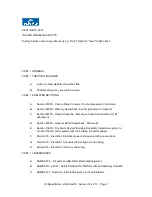
8
9
930356 Rev. B
930356 Rev. B
I V .
N O T I C E — R E A D B E F O R E U S E
V .
G E N E R A L W A R N I N G S
A. WEIGHT LIMIT
NEVER exceed the weight limit of 250 pounds (113.6 kilograms), for combined
weight of rider and items carried. If you do exceed the limit, damage to your
chair, a fall, tip-over or loss of control may occur and cause severe injury to the
rider or others.
B. WEIGHT TRAINING
NEVER use this chair for weight training if total weight (rider plus equip-
ment) exceeds 250 pounds. If you do exceed the limit, damage to your chair,
a fall, tip-over or loss of control may occur and cause severe injury to the
rider or others.
C. GETTING TO KNOW YOUR CHAIR
Every wheelchair is different.Take the time to learn the feel of this chair
before you begin riding. Start slowly, with easy, smooth strokes. If you are
used to a different chair, you may use too much force and tip over. If you use
too much force, damage to your chair, a fall, tip-over or loss of control may
occur and cause severe injury to the rider or others.
D. TO REDUCE THE RISK OF AN ACCIDENT
1.
BEFORE riding, you should be trained in the safe use of this chair by your
health care advisor.
2.
Practice bending, reaching and transfers until you know the limit of your
ability. Have someone help you until you know what can cause a fall or
tip-over and how to avoid doing so.
3.
Be aware that you must develop your own methods for safe use best
suited to your level of function and ability.
4.
NEVER try a new maneuver on your own until you are sure you can
do it safely.
5.
Get to know the areas where you plan to use your chair. Look for
hazards and learn how to avoid them.
6.
Use anti-tip tubes unless you are a skilled rider of this chair and are sure
you are not at risk to tip over.
If you fail to heed these warnings damage to your chair, a fall, tip-over or loss of
control may occur and cause severe injury to the rider or others.
A. CHOOSE THE RIGHT CHAIR & SAFETY OPTIONS
Sunrise provides a choice of many wheelchair styles to meet the needs of the
wheelchair rider. However, final selection of the type of wheelchair, options and
adjustments rests solely with you and your health care advisor. Choosing the
best chair and set-up for your safety depends on such things as:
1.
Your disability, strength, balance and coordination.
2.
The types of hazards you must overcome in daily use (where you live and
work, and other places you are likely to use your chair).
3.
The need for options for your safety and comfort (such as anti-tip tubes,
positioning belts, or special seating systems).
B. REVIEW THIS MANUAL OFTEN
Before using this chair you, and each person who may assist you, should
read this entire manual and make sure to follow all instructions. Review the
warnings often, until they are second nature to you.
C. WARNINGS
The word
“WARNING”
refers to a hazard or unsafe practice that may
cause
severe injury or death
to you or to other persons.The “Warnings”
are in four main sections, as follows:
1.
V — GENERAL WARNINGS
Here you will find a safety checklist and a summary of risks you need to be
aware of before you ride this chair.
2.
VI — WARNINGS — FALLS & TIP-OVERS
Here you will learn how to avoid a fall or tip-over while you perform daily
activities in your chair.
3.
VII — WARNINGS — FOR SAFE USE
Here you will learn about practices for the safe use of your chair
4.
VIII — WARNINGS — COMPONENTS & OPTIONS
Here you will learn about the components of your chair and options you can
select for safety. Consult your authorized supplier and your health care advisor
to help you choose the best set-up and options for safe use.
Note:
Where they apply, you will also find “Warnings” in other sections of this manual.
Heed all warnings in this section. If you fail to do so a fall, tip-over or loss of control may
occur and cause severe injury to the rider or others.
Содержание Quickie T45
Страница 20: ...39 930356 Rev B 38 930356 Rev B N O T E S...






































